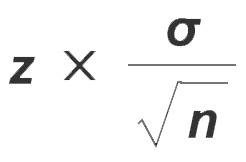What is Margin of Error Importance reading and calculation
Margin of Error
The margin of error is the index that determines the maximum error estimate of the results of a survey.
Explanation
With the exception of census research, in which everyone in the universe of that research is interviewed to obtain a result that is 100% representative of reality, all research is carried out based on samples. In other words, the values of a survey are not absolute but rather statistical estimates within a universe.
In this sense, this means that, to respond to a survey, people with common characteristics are selected, who represent the group being researched.
Therefore, these characteristics can be social class, age group, age or even more specific aspects, such as, for example, “people who had a child in the last year”, “people who bought an apartment in the last six months”, “people who have pets”, among others.
Finally, it is necessary to randomly select a sample of people from the total number of people with such characteristics so that they respond to the survey, and the opinion of these people will represent the opinion of the whole, that is, the universe of that survey.
How important is it to calculate
Calculating the margin of error for a survey and having this data at hand is essential for measuring the reliability of the data. After all, if you don’t have access to this index, how will you know how accurate the research data is?
Therefore, make sure that the margin of error has been properly calculated in your research to make concrete decisions based on the data.
How to read the margin of error of a survey?
Let’s look at a practical example: let’s say the margin of error for a survey is five percentage points. This means that if 60% of respondents said they were satisfied with your product, you should consider the actual product approval percentage to be between 55% and 65%.
Furthermore, in the case of electoral polls, where the margin of error is always well remembered, the scientific method and the way in which we can make conjectures. However, it is sometimes difficult to understand the logic is the same. Candidates who present 49% of voting intentions cannot necessarily count on this number. If the survey‘s margin of error is around 2%, for example, what does that mean? Simple: the candidate can either have the 51% that would give him victory, or he can only have 47%, depending on the margin.
In general, obviously, the higher the index, the less accurate your search data will be. To reduce the rate, the solution is for your sample to be as representative as possible of the total group that you consider to be your audience. In other words, the more interviews you do, the smaller your margin for error will be.
Survey Confidence Index
Another important index is the confidence interval. Many people even confuse the margin of error with the confidence index of a survey. However, the concepts are different.
The confidence interval – or level – represents the probability that a survey would obtain the same results, respecting the margin of error, if another group of people in the same population were interviewed.
Therefore, consider a survey with a 95% confidence level. This means that, if it were redone 100 times, in 95 times it would present results within the error range.
The calculation of the margin of error is done by statisticians , who use knowledge learned at a higher level to understand the distribution of the data collected and calculate the margin of error, which is given by the formula:

n: is the sample size.
σ: is the population standard deviation.
z: is the desired confidence level score.
To find z it is necessary to consult a standard normal distribution table, and its value directly depends on the level of confidence desired for the data. This means that if the research has 95% confidence, we will use a value for z, which is 1.96 (found by consulting the standard normal distribution table). For different values of survey confidence level, we have different values for z. Normally, to calculate the margin of error, research institutes use programs that already offer the calculation of the margin of error , according to the sample value, the standard deviation and the desired level of confidence.”
The ideal margin of error for a survey
Now you may be wondering: okay, but what is the ideal margin of error for market research?
The answer is that there is no absolute number to answer this question. Everything will depend on the complexity of your research and its sample. However, the best option, of course, is to work with the smallest possible margin .
Anyone who intends to launch a new product or carry out a campaign recall, for example, should not work with a higher margin of error. 50 interviews and a 13.9% margin of error, for example, may leave the results inconclusive. In these examples, it is riskier to make the decision in the face of so much statistical variation.
The exercise then is to ask yourself how close to accuracy your research needs to come. How many interviews will you actually need to do? Depending on the objective of your market research, a higher or lower margin will work perfectly.
Think carefully when defining your research sample. If in doubt, consult our content on research sampling to avoid mistakes.




